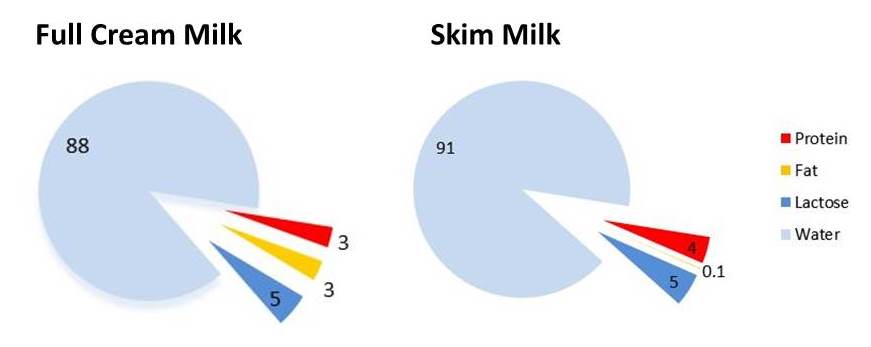- Home
- Blog
- Carbs, Sugars and Fibres
- Does skim milk have more sugar than full-fat milk?
Does skim milk have more sugar than full-fat milk?
Written by
on Wednesday, 07 September 2016.
Tagged: carbohydrates, carbs, health, healthy eating, healthy lifestyle, low fat, milk, nutrition, sugar

A friend told me that she’s stopped drinking skim milk because it has “added sugar”. She’s gone back to the full-cream milk she once drank as a kid growing up. My first thought was "Whoa! Fresh plain milk doesn’t contain any added sugar unless you’re drinking flavoured milk like chocolate milk or strawberry milk."
A Foodwatch investigation
Maybe my friend was mixing up the natural sugar of milk, known as lactose, with added sugar, known as sucrose?
Lactose is a disaccharide (double-sugar) but is analysed under the blanket term “sugars” on the food label. So is ordinary sugar. What’s more, all sugars ARE in fact carbohydrates.
I decided to investigate. I compared two milks from the same company – one a skim milk at almost no fat and one a regular full-fat milk at 3.4 per cent fat. Here’s what I found.
Comparison of milks – full-fat vs skim
| Component per 100 mL |
Full-fat milk |
Skim milk |
Change |
| Energy, kJ | 266 | 147 | ↓ |
| Protein, g | 3.4 | 3.5 | ↑ |
| Fat -total , g | 3.4 | 0.1 | ↓ |
| Fat - Saturated, g | 2.3 | 0.1 | ↓ |
| Carbohydrate, g | 4.8 | 4.9 | ↑ |
| Sugars, g | 4.8 | 4.9 | ↑ |
| Sodium, mg | 44 | 45 | ↑ |
| Calcium, mg | 128 | 132 | ↑ |
Source: Dairy Farmers website
What the table shows
Row 2 for energy: Skim milk has had almost all its fat skimmed off, so it has fewer kilojoules or Calories. Fat contributes the most kilojoules - double that of protein or lactose. Its energy has dropped from 266 to only 147.
Row 7 for sugars: when you remove the fat from whole milk, you concentrate what remains. So the sugars go from 4.8 to 4.9 per cent, plus the protein, sodium and calcium go up.
In other words, if you start with 100 mLs of full-fat milk, then remove the 5 per cent fat to create a fat-free skim milk, you end up with only 95 mLs of final skim milk. That 95 mLs turned into a percentage magnifies what was there. Take a look at my diagram in order to see this at a glance.

The yellow section is the Fat content which drops from 3.4 per cent to almost zero in skim milk. The dark blue (lactose) and red (protein) increase slightly. There is more pale blue (water) in skim milk.
Lactose and sweetness
- Skim milk sometimes tastes slightly sweeter, thanks to this higher content of natural lactose and because the fat isn't there any more to round out the flavour. However, this doesn’t mean you’re consuming any added sugar (which is extracted and purified from cane sugar).
- This natural sugar is the problem in lactose intolerance, which is caused by an inability to digest the lactose in milk. Most people can tolerate small amounts of milk, say in tea or coffee and over cereal. But not a large milk shake on an empty stomach.
- Lactose is better managed if eaten with other foods (say milk in porridge) or spread out over the day, rather than being eaten in large amounts at once. In fact, people with lactose intolerance are better off drinking full-fat milk with its natural fat - which helps slow down the digestion of the milk.
The bottom line
Plain skim milk (or low-fat or light milk) doesn’t have any sugar added to it. Drink full-fat milk if you like the taste, but not because you take in LESS sugar – you don’t.
Save
Save
Save
Save
Save
Save
Save
Save
Save
Foodwatch
The Good Stuff
The Boring Stuff
© 2025 Foodwatch Australia. All rights reserved
Website by Joomstore eCommerce





